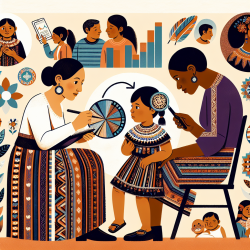Introduction
As speech-language pathologists, our goal is to create the best possible outcomes for children. This requires not only understanding the challenges they face but also leveraging research and data-driven strategies to overcome these barriers. A recent study titled Barriers to accessing and using contraception in highland Guatemala: the development of a family planning self-efficacy scale provides valuable insights that can be applied to our field. By examining the barriers indigenous women in Guatemala face regarding family planning, we can draw parallels to the challenges children encounter in speech therapy and develop strategies to enhance their outcomes.
Understanding Barriers Through Social Cognitive Theory
The research conducted by Richardson et al. (2016) employs Bandura’s Social Cognitive Theory to explore the barriers indigenous women face in accessing contraception. This theory emphasizes the triadic relationship between behavioral, cognitive, and environmental influences. In the context of speech therapy, this approach can help us understand the barriers children face in communication and how to address them effectively.
Key Findings and Their Implications for Speech Therapy
- Lack of Knowledge and Resources: Just as the Guatemalan women lacked knowledge about contraception, children may lack awareness of communication strategies. Providing comprehensive education and resources can empower children and their families.
- Fear and Misconceptions: The fear of side effects and misconceptions about contraception in the study parallels the anxiety children might feel about therapy. Addressing these fears through clear communication and reassurance is crucial.
- Social and Cultural Pressures: The influence of social norms on family planning decisions mirrors the impact of cultural expectations on children's communication development. Understanding and respecting cultural contexts can improve therapy outcomes.
Applying the Self-Efficacy Scale to Speech Therapy
The self-efficacy scale developed in the study provides a framework for assessing confidence in overcoming barriers. In speech therapy, creating a similar scale can help practitioners identify specific challenges children face and tailor interventions accordingly. This approach ensures that therapy is personalized and effective.
Encouraging Further Research and Collaboration
While the study focuses on family planning, its methodology and findings offer valuable lessons for speech therapy. Encouraging further research and collaboration between fields can lead to innovative strategies that benefit children. By understanding the unique barriers each child faces, we can develop targeted interventions that foster communication skills and overall development.
Conclusion
The research on family planning in Guatemala highlights the importance of understanding and addressing barriers to improve outcomes. By applying these insights to speech therapy, we can enhance our practice and create better outcomes for children. To read the original research paper, please follow this link: Barriers to accessing and using contraception in highland Guatemala: the development of a family planning self-efficacy scale.










